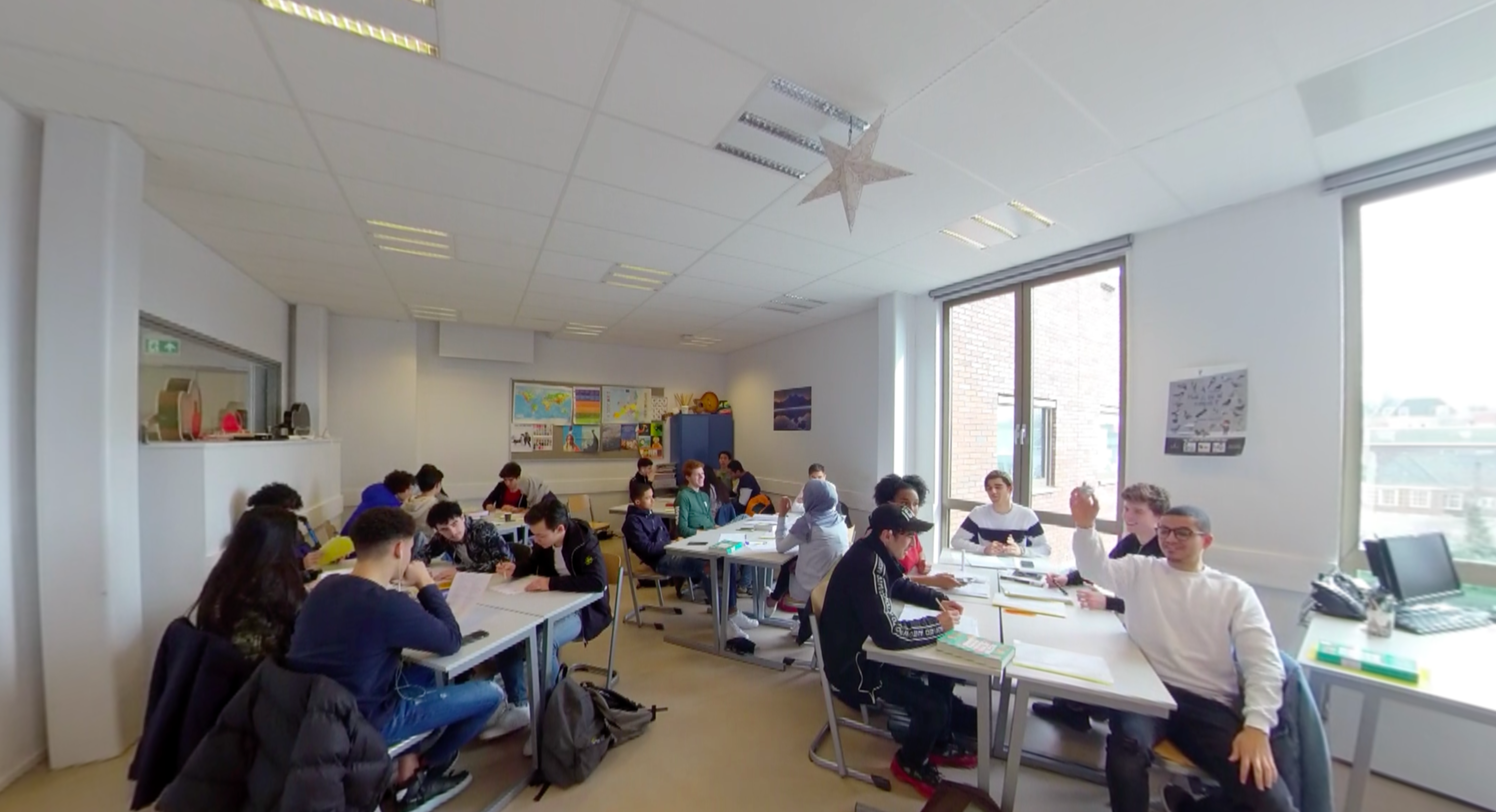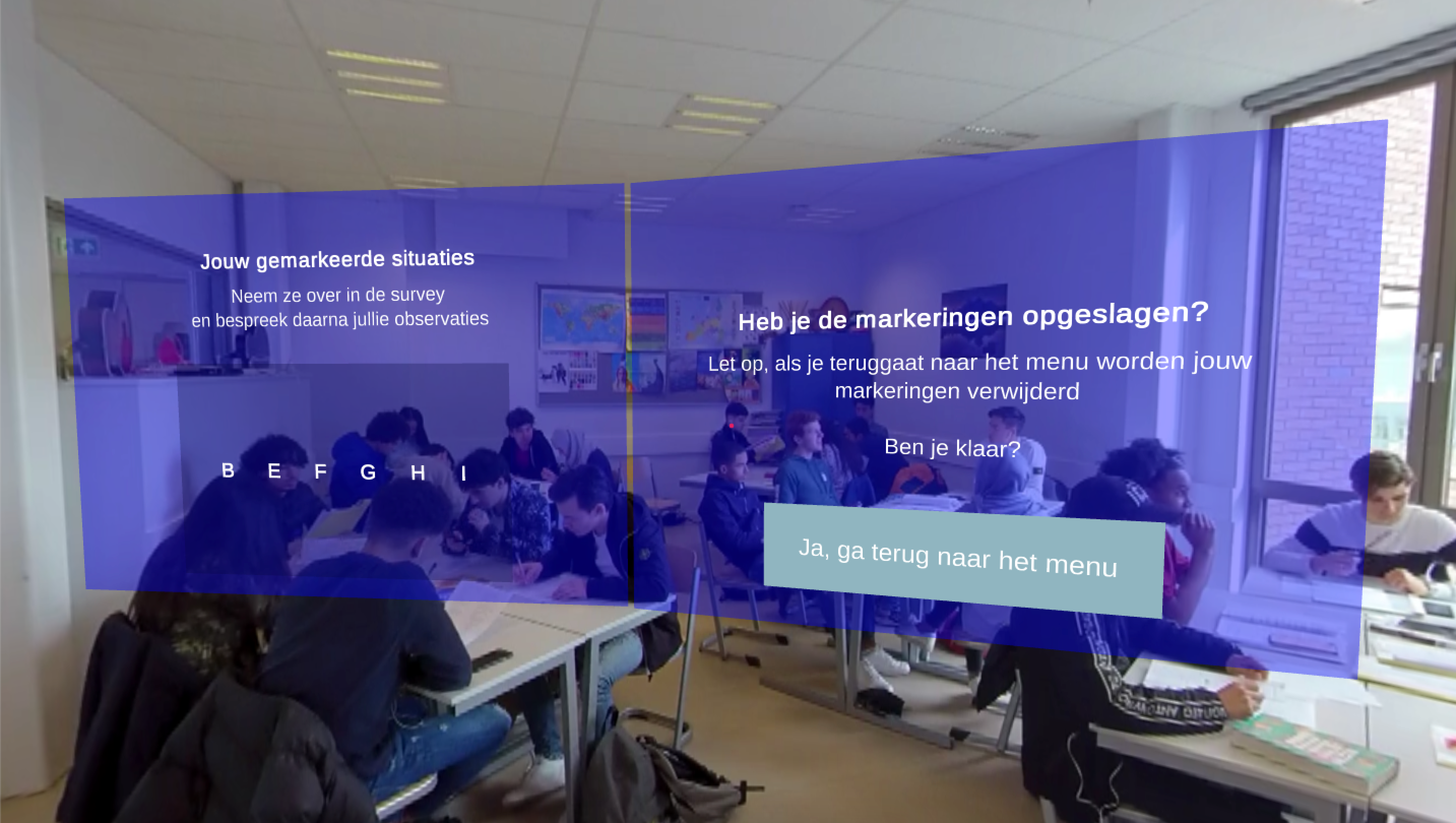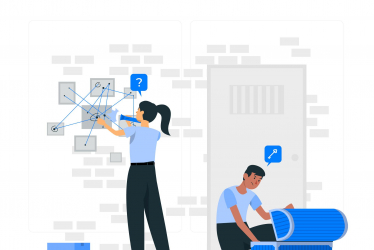Projects
The Classroom Experience: student-teachers learn noticing skills in VR
The Centre for Innovation together with the Leiden University Graduate school of teaching developed the application The Classroom Experience. It offers student-teachers a way to experience and reflect upon simulated classroom situations that they could experience during their later careers as teachers in a classroom. By making use of 360° video, student-teachers can experience classroom challenges in a realistic way and feel like they are part of a live scenario.
The Classroom Experience | Project Details
Partner: Leiden University Graduate School of Teaching (ICLON) Juan Espinola y Vásquez (Lecturer, initiator), Brigitte Theeuwes (Lecturer), Nadira Saab (Associate Professor)
Main target group: Student-teachers (students of the Graduate School of Teaching)
This project is a result of the 360° VR Pilot Program that was initiated by the Centre for Innovation in 2017. Aim of the program is to explore the potential of 360° video based VR experiences for teaching and learning in academic education. After selection, six pioneering applicants from different faculties at Leiden University were invited to take part. In each project, the applying faculty members acted as partner and together with the Centre for Innovation created an innovative learning experience for their educational challenge. Read more about the 360 VR Pilot here.
Educational Challenge
Teachers are faced every day with straightforward questions about their classroom: How can I notice everything? How can I keep order in a busy classroom? How do I address cultural differences in my students? For most teachers, the answers to these questions come with experience. The more years they spend in front of the classroom, the better they can handle these issues.
A classroom is a complex and dynamic environment. Good teachers balance form and content in their lessons by observing and adjusting to classroom dynamics. The ability to balance comes with experience, which is why it’s hard for first-time teachers to focus on more than just transferring subject matter. While practicing in the field will always be necessary, a real classroom with teenage pupils is a challenging training environment because it lacks space and time for reflection and practise. Thereby, it is hard to transfer experiences and knowledge gained from the classroom to your fellow student-teachers without having recorded a situation.
Based on these observations, the following challenges were defined: how can we train the observational skills of our teachers-to-be before they have to face the classroom for the first time? To address this challenge, we needed to find a way to make teachers aware them aware of observational skills and discuss their observations made in a safe but realistic setting.
In this app, users are able to place markers on moments of interest. This feature acts as the basis for follow-up discussions on observations made in-app, and the teacher-educators gain insight on the individual approaches of student-teachers. With this VR experience, we want to give soon-to-be teachers a head start to become aware of their noticing skills.
 360° video is used to capture different classroom situations
360° video is used to capture different classroom situationsThe Classroom Experience
The 360° VR Oculus Go application The Classroom Experiences is integrated in a larger exercise on noticing skills for student-teachers. At the start, the teacher-educator introduces the medium and invites student-teachers (later called users) to view the The Classroom Experience. Students-teachers are instructed to pay close attention to actors and behaviours shown in the videos, mark notable moments and think about what decisions and responses would be appropriate in a real life classroom situation.
Then student-teachers are exposed to four classroom scenarios captured in 360° video. In these scenarios, pupils show potentially disruptive behaviour. In real-life, it is up to the teacher how to act upon these situations, so is the case in this exercise. When a user pushes the trigger on the Oculus Go controller during a video, the current moment in the video is matched to the section it falls in. When the video is finished, the user gets an overview of all sections he or she marked. This overview is then used in reflection with their fellow students and the teacher.
All users’ marked sessions are collected through an online survey. The teacher-educator can use the resulting data as a basis to start the discussion and to reflect on individual differences between his student-teachers. After exposure to the cases, student-teachers and teacher-educators together us the defined in-app markers to discuss observations and how the app informs real life classroom situations. During this discussion,they have access to the marked version of each video-scenario they just watched. Users can jump to specific predefined moments in the timeline of a video. In this way, different viewers can easily communicate about moments of interest and rewatch them together. Viewer 1 shares that they marked section ‘c’, viewer 2 can directly click on section ‘c’ to watch it and then both viewers can discuss the situation together. Marked videos are published on the Kaltura platform, the video service of Leiden University.
 At the end of each scenario video, users are provided with an overview of sections they marked.
At the end of each scenario video, users are provided with an overview of sections they marked. Creating a marking functionality
The video-scenarios included in this app should reflect real life classroom situations that were multi-interpretable and interesting to watch multiple times. Designs of the scenarios were provided by our partners Juan Espinola y Vásquez and Brigitte Theeuwes (Lecturer) from the Leiden University Graduate School of Teaching. The resulting four videos cover a wide range of classroom situations. They include a group of about 25 students interacting with each other and showing a variety of different behaviours. Users must pay attention while using the app because they are forced to look around and it is impossible to see everything the first time. To increase this aspect even more, it would be interesting to experiment with different camera positions in future projects. To ensure that the experience resembles a realistic teaching situation for the final users, our application positions the camera in the original teaching position: the front of the classroom.
Because the most important lessons are learned during reflection after users interact with the app, the experience enables users to mark moments they think are notable. Users can then share these moments with fellow students and the teacher for further reflection and analysis. Incorporating this feature was one of the biggest challenges in this project and the development team came up with different solutions for this requirement.
The development team considered building a system that analyses where users look throughout the video. However, to make the experience future proof and standalone, we aimed to eliminate integration with other systems that would need additional maintenance. Analysis of user behaviour would require sending messages from within a head mounted display to a server / other computer system. This would bring up bring along security issues.
Our second possible solution was to mark specific moments within the experience when users are exposed to the scenario for the first time. Selection of specific moments cannot be not done after the first time viewing, to eliminate chances on ‘over-analysis’.
Finally, the teacher educator should have access to student-teachers’ documentation of observations made to gain insight into student-teacher decision making processes, degree of teaching awareness and to discuss observations with the student group. To meet this requirement, we realised we could simply giving users an overview of their marked sections at the end of each video and ask them to check their marked sections in a Qualtric survey after. These data can then easily be directly sent to the teacher.
Reactions and Implementation
Student-teachers will mostly be doing this exercise during a workshop that is part of the course Learning and Instruction that is provided by Leiden University Graduate School of Teaching (ICLON). The exercise could also be used at other times during their course program and may be interesting for other parties as well. The first test with students of ICLON will be done by the end of June 2019. We are hoping to see positive results and look forward to conducting future projects in the theme of teaching skills and experimenting with the potential of marking videos for educational purposes as a wide-spread teaching and learning enhancement.



